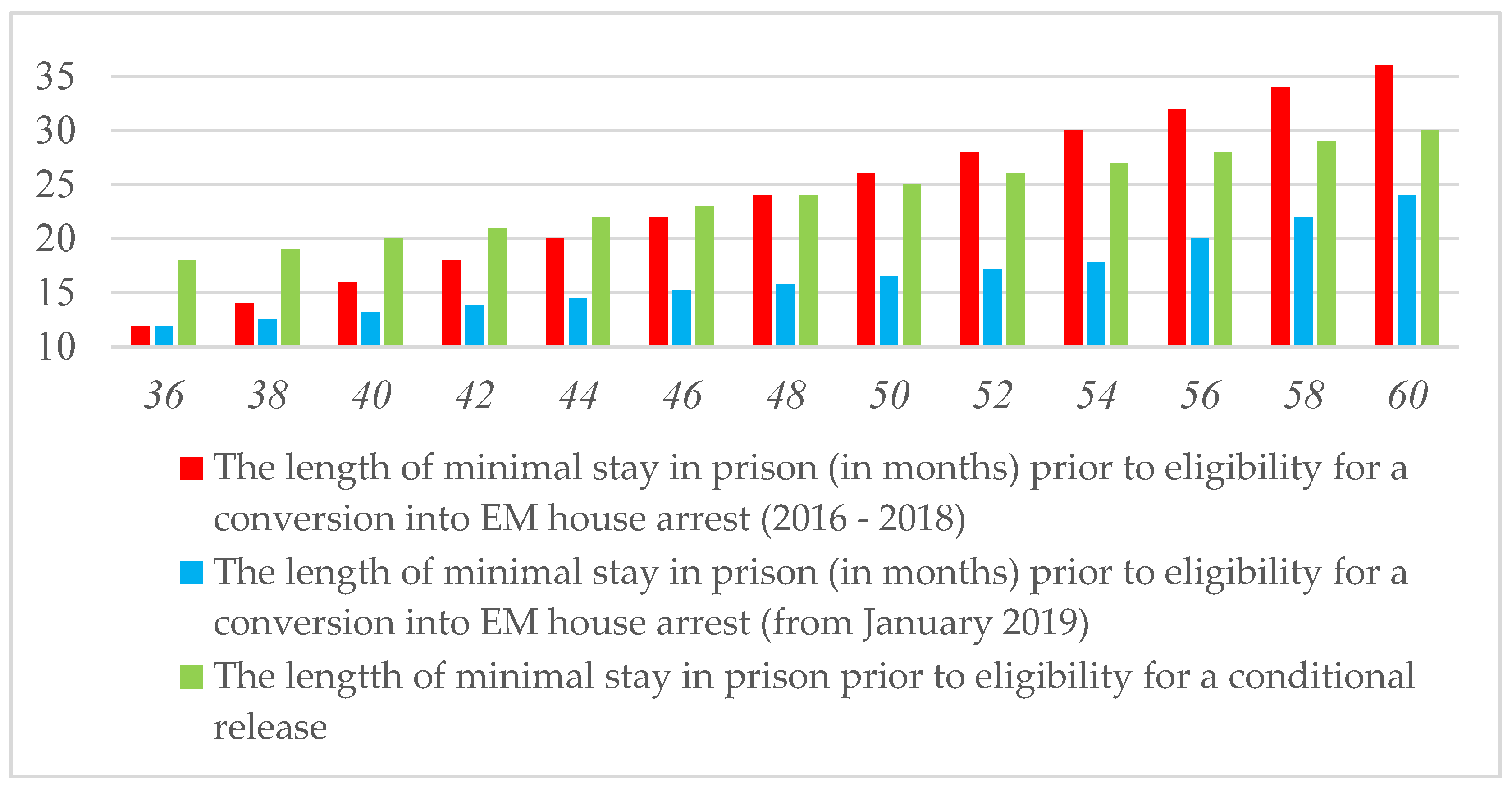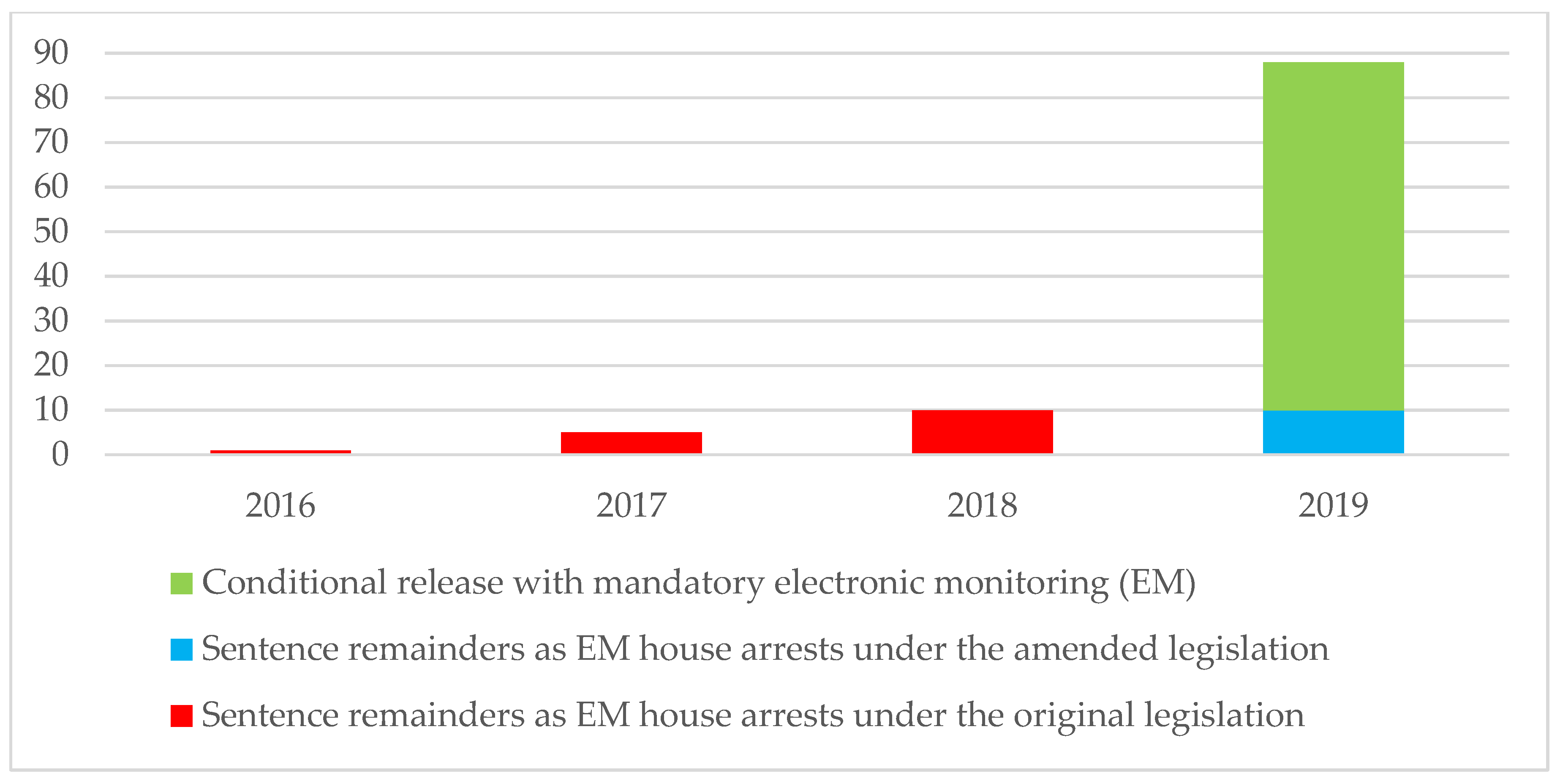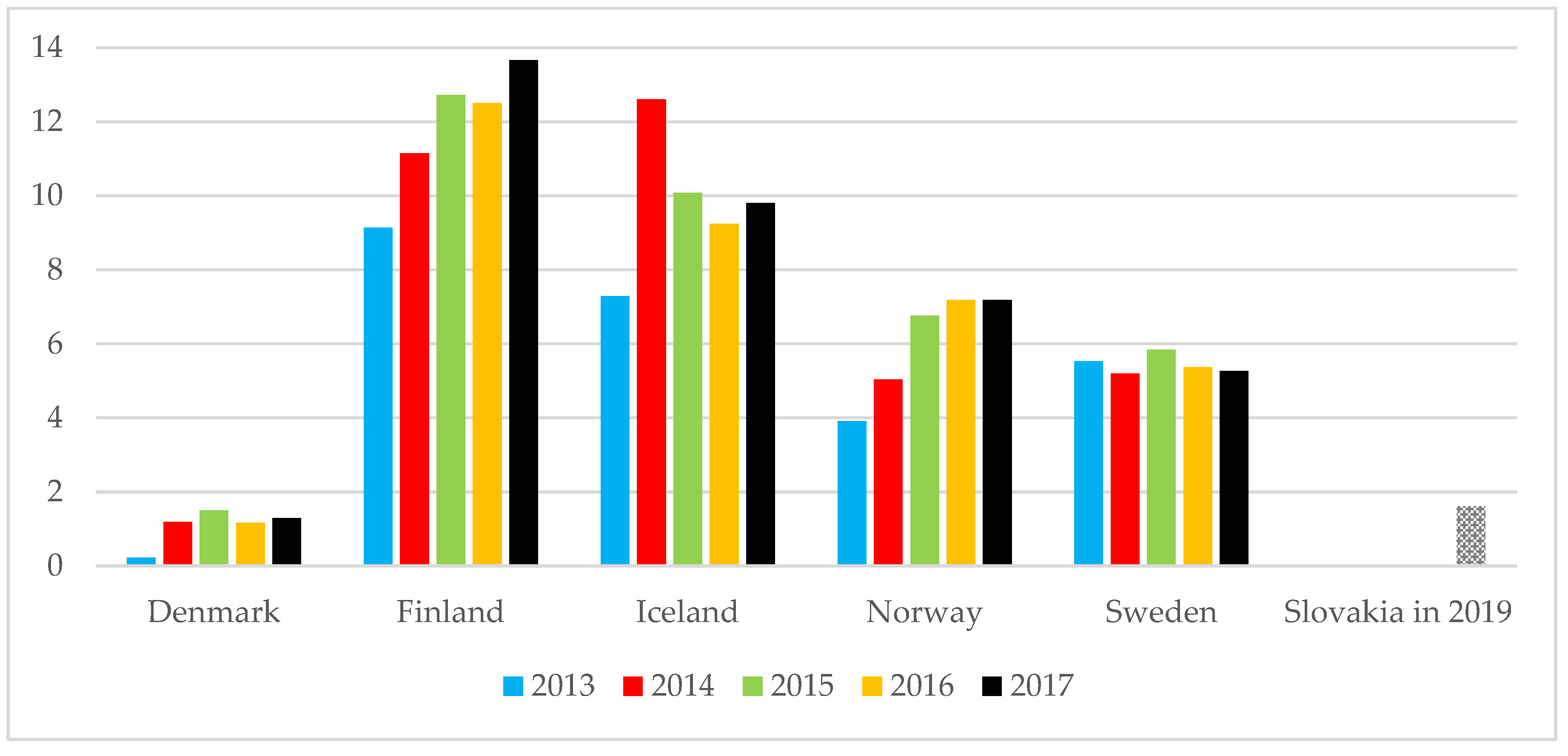Sustainable Policy Measures Based on Implementation of Digital Technologies in Corrections: Exploratory Study from Slovakia and Beyond
Abstract
1. Introduction
2. Materials and Methods
3. Results
3.1. Electronic Monitoring as a Sustainability Measure in the Socio-Economic Context
3.1.1. Cost Effectiveness of EM
3.1.2. Results of the National Survey on EM Sustainability Measures
3.2. Electronic Monitoring as a Sustainability Measure in the Legal Context
3.2.1. Settings for the EM “Back-Door” Scheme under the Original Laws (2016–2018)
3.2.2. Settings for the EM “Back Door” Scheme under the Amended Laws (Since 2019)
3.2.3. Comparisons of the Original and Amended Conditions for Converting Remaining Prison Sentences into EM Monitored House Arrests
3.2.4. Practical Application of the “Back Door” EM Scheme 2016–2019 and Sustainability Patterns of EM in the Legal Context
4. Conclusions
Author Contributions
Funding
Acknowledgments
Conflicts of Interest
References
- Adams, M.; Klinsky, S.; Chhetri, N. Barriers to sustainability in poor marginalized communities in the united states: The criminal justice, the prison-industrial complex and foster care systems. Sustainability 2019, 12, 220. [Google Scholar] [CrossRef]
- Clear, T.R. Imprisoning Communities: How Mass Incarceration Makes Disadvantaged Neighborhoods Worse; Oxford University Press: Oxford, UK, 2007. [Google Scholar]
- Bazelon, E. Charged: The New Movement to Transform American Prosecution and End Mass Incarceration; Random House: New York, NY, USA, 2019; ISBN 0399590013. [Google Scholar]
- Krištofík, P.; Borseková, K.; Koróny, S.; Mihók, P. Classical and alternative methods of punishment: Economic comparison based on European evidence. In Proceedings of the 7th International Conference on Interdisciplinary Social Science Studies, Oxford, UK, 13–15 November 2017; pp. 85–94. [Google Scholar]
- Nellis, M. The electronic monitoring of offenders in England and Wales. Br. J. Criminol. 1991, 31, 165–185. [Google Scholar] [CrossRef]
- Payne, B.K.; Gainey, R.R. Electronic monitoring. J. Offender Rehab. 2000, 31, 93–111. [Google Scholar] [CrossRef]
- Renzema, M.; Mayo-Wilson, E. Can electronic monitoring reduce crime for moderate to high-risk offenders? J. Exp. Criminol. 2005, 1, 215–237. [Google Scholar] [CrossRef]
- Black, M.; Smith, R.G. Electronic monitoring and the criminal justice system. Trends Issues Crime Crim. Justice 2003, 254, 1–6. [Google Scholar]
- Nellis, M. Electronic monitoring, satellite tracking, and the new punitiveness in England and Wales. In The New Punitiveness: Trends, Theories, Perspectives; Routlege: New York, NY, USA, 2013; pp. 167–188. [Google Scholar]
- Ardley, J. The theory, development and application of electronic monitoring in Britain. Internet J. Criminol. 2005, 1–54. Available online: www.internetjournalofcriminology.com (accessed on 19 September 2020).
- Whitfield, D. Tackling the Tag: The Electronic Monitoring of Offenders; Waterside Press: Winchester, UK, 1997. [Google Scholar]
- Erez, E.; Ibarra, P.R.; Bales, W.D.; Gur, O.M. GPS Monitoring Technologies and Domestic Violence: An Evaluation Study; American Psychological Association: Washington, DC, USA, 2013. [Google Scholar]
- Finn, M.A.; Muirhead-Steves, S. The effectiveness of electronic monitoring with violent male parolees. Justice Q. 2002, 19, 293–312. [Google Scholar] [CrossRef]
- Martinovic, M. The punitiveness of electronically monitored community based programs. In Proceedings of the Probation and Community Corrections Officers’ Association Inc. Conference, Perth, Australia, 23–24 September 2002. [Google Scholar]
- Nellis, M.; Beyens, K.; Kaminski, D. Electronically Monitored Punishment: International and Critical Perspectives; Routledge: London, UK, 2013. [Google Scholar]
- Beyens, K.; Roosen, M. Electronic monitoring in Belgium: A penological analysis of current and future orientations. Eur. J. Probat. 2013, 5, 56–70. [Google Scholar] [CrossRef]
- Boone, M.; Pakes, F.; Van Wingerden, S. Explaining the collapse of the prison population in the Netherlands: Testing the theories. Eur. J. Criminol. 2020. [Google Scholar] [CrossRef]
- Henneguelle, A.; Monnery, B.; Kensey, A. Better at home than in prison? The effects of electronic monitoring on recidivism in France. J. Law Econ. 2016, 59, 629–667. [Google Scholar] [CrossRef]
- Dünkel, F.; Thiele, C.; Treig, J. “You’ll never stand-alone”: Electronic monitoring in Germany. Eur. J. Probat. 2017, 9, 28–45. [Google Scholar] [CrossRef]
- Mair, G. Electronic monitoring, effectiveness, and public policy. Criminol. Public Policy 2006, 5, 57–59. [Google Scholar] [CrossRef]
- DeMichele, M. Electronic monitoring: It is a tool, not a silver bullet. Criminol. Public Policy 2014, 13, 393–400. [Google Scholar] [CrossRef]
- Lilly, J.R. Issues beyond empirical EM reports. Criminol. Public Policy 2006, 5, 93–101. [Google Scholar] [CrossRef]
- Nellis, M. Surveillance, rehabilitation, and electronic monitoring: Getting the issues clear. Criminol. Public Policy 2006, 5, 103–108. [Google Scholar] [CrossRef]
- Nellis, M. Surveillance and confinement: Explaining and understanding the experience of electronically monitored curfews. Eur. J. Probat. 2009, 1, 41–65. [Google Scholar] [CrossRef]
- Vanhaelemeesch, D.; Beken, T.V.; Vandevelde, S. Punishment at home: Offenders’ experiences with electronic monitoring. Eur. J. Criminol. 2013, 11, 273–287. [Google Scholar] [CrossRef]
- Hucklesby, A.; Beyens, K.; Boone, M.; Dunkel, F.; McIvor, G.; Graham, H. Creativity and Effectiveness in the Use of Electronic Monitoring: A Case Study of Five Jurisdictions; European Commission; University of Leeds: Leeds, UK, 2016. [Google Scholar]
- Hucklesby, A.; Holdsworth, E. Electronic Monitoring in England and Wales. EMEU Project Report; University of Leeds: Leeds, UK, 2016. [Google Scholar]
- Hucklesby, A. Vehicles of desistance? Criminol. Crim. Justice 2008, 8, 51–71. [Google Scholar] [CrossRef]
- Gibbs, A. A letter from New Zealand: Home detention—Emerging issues after the first three years. Crime Prev. Community Saf. 2004, 6, 57–64. [Google Scholar] [CrossRef]
- Gibbs, A.; King, D. The electronic ball and chain? The operation and impact of home detention with EM in New Zealand. Aust. N. Z. J. Criminol. 2003, 36, 1–17. [Google Scholar] [CrossRef]
- Shosham, E.; Yehosha-Stern, S.; Efodi, R. Socio-legal characteristics and parole infractions among israeli released prisoners during electronic monitoring. Int. J. Offender Ther. Comp. Criminol. 2013, 57, 864–887. [Google Scholar] [CrossRef] [PubMed]
- Shosham, E.; Yehosha-Stern, S.; Efodi, R. Recidivism among licenced released prisoners who participated in the EM program in Israel. Int. J. Offender Ther. Comp. Criminol. 2014, 59, 1–17. [Google Scholar]
- Di Tella, R.; Schargrodsky, E. Criminal Recidivism after Prison and Electronic Monitoring. J. Politi- Econ. 2013, 121, 28–73. [Google Scholar] [CrossRef]
- Slovak Legislation: Act No. 78/2015 Coll. on Control of the Enforcement of Certain Decisions by Technical Instruments. Available online: https://www.slov-lex.sk/web/en (accessed on 30 September 2020).
- Nellis, M. Survey of Electronic Monitoring (EM) in Europe: Analysis of Questionnaires 2013 Strasbourg: Council of Europe. 2013. Available online: https://rm.coe.int/16806f9833 (accessed on 10 May 2020).
- Aebi, M.F.; Delgrande, N. Council of Europe Annual Penal Statistics. SPACE I. Survey 2013. Available online: http://wp.unil.ch/space/files/2015/02/SPACE-I-2013-English.pdf (accessed on 20 May 2020).
- Aebi, M.F.; Tiago, M.M.; Burkhards, C. Council of Europe Annual Penal Statistics. SPACE I. Survey 2015. 2017. Available online: http://wp.unil.ch/space/files/2017/04/SPACE_I_2015_FinalReport_161215_REV170425.pdf (accessed on 10 May 2020).
- Laurie, E.; Maglione, G. The electronic monitoring of offenders in context: From policy to political logics. Crit. Criminol. 2019, 27, 1–18. [Google Scholar] [CrossRef]
- Borsekova, K. Implementation of social responsibility approach into electronic monitoring: Challenge for public sector services. In Environmental Issues in Supply Chain Management; Springer Science and Business Media LLC: Berlin/Heidelberg, Germany, 2018; pp. 193–221. [Google Scholar]
- Belur, J.; Thornton, A.; Tompson, L.; Manning, M.; Sidebottom, A.; Bowers, K. A systematic review of the effectiveness of the electronic monitoring of offenders. J. Crim. Justice 2020, 68, 101686. [Google Scholar] [CrossRef]
- Garland, D. The Culture of Control: Crime and Social Order in Contemporary Society; Oxford University Press: Oxford, UK, 2002. [Google Scholar]
- Vitálišová, K.; Borseková, K.; Vaňová, A. Benefits and risks associated with the electronic monitoring of accused and convicted persons implementation from the community life point of view. In Proceedings of the 7th Central European Conference in Regional Science, Sopron, Hungary, 9–11 October 2019. [Google Scholar]
- National Audit Office. The EM of Offenders. 2006. Available online: https://www.nao.org.uk/report/the-electronic-monitoring-of-adult-offenders/ (accessed on 26 March 2020).
- Dodgson, K.; Goodwin, P.; Howard, P.; Clewellyn-Thomas, S.; Mortimer, E.; Russell, N.; Weiner, M. EM of Released Prisoners: An Evaluation of the Home Detention Curfew Scheme, Home Office Research Study 222; Home Office: London, UK, 2001.
- Mair, G.; Mortimer, E. Curfew Orders with Electronic Monitoring; Home Office Research and Statistics Directorate: London, UK, 1996.
- Mair, G.; Nee, C. Electronic Monitoring. The Trials and Their Results, Home Office Research Study No. 120; The Stationary Office: London, UK, 1990. [Google Scholar]
- Shute, S. Satellite Tracking of Offenders. A Study of the Pilots in England and Wales, Research Summary 4; Ministry of Justice: London, UK, 2007.
- Sugg, D.; Moore, L.; Howard, P. Electronic Monitoring and Offending Behaviour—Reconviction Results for the Second Year of Trials of Curfew Orders; Home Office Research Findings 141: London, UK, 2001.
- Borseková, K.; Krištofík, P.; Koróny, S.; Mihók, P.; Vaňová, A. Electronic monitoring as an alternative form of punishment: An exploratory study based on European evidence. In Proceedings of the 7th International Conference on Interdisciplinary Social Science Studies, Oxford, UK, 13–15 November 2017; pp. 95–107. [Google Scholar]
- Aebi, M.F.; Tiago, M.M. SPACE I—Council of Europe Annual Penal Statistics: Prison Populations; Council of Europe: Strasbourg, France, 2018. [Google Scholar]
- Vitálišová, K.; Mihók, P.; Vaňová, A. Electronic monitoring of convicted and accused persons as a more cost-efficient way of punishment. In Proceedings of the Právne a Ekonomické Súvislosti Elektronického Monitoringu Obvinených a Odsúdených Osôb, Banská Bystrica, Slovakia, 21–22 November 2019; pp. 414–424. [Google Scholar]
- Cohen, M.A.; Piquero, A.R. New evidence on the monetary value of saving a high risk youth. J. Quant. Criminol. 2009, 25, 25–49. [Google Scholar] [CrossRef]
- Marklund, F.; Holmberg, S. Effects of early release from prison using electronic tagging in Sweden. J. Exp. Criminol. 2009, 5, 41–61. [Google Scholar] [CrossRef]
- Nellis, M. Surveillance, stigma and spatial constraint: The ethical challenges of electronic monitoring. In Electronically Monitored Punishment: International and Critical Perspectives; Nellis, M., Beyens, K., Kaminski, D., Eds.; Routledge: Oxford, UK, 2013; pp. 193–210. [Google Scholar]
- Padgett, K.G.; Bales, W.D.; Blomberg, T.G. Under surveillance: An empirical test of the effectiveness and consequences of electronic monitoring. Criminol. Public Policy 2006, 5, 61–91. [Google Scholar] [CrossRef]
- Payne, B.K.; DeMichele, M. Sex offender policies: Considering unanticipated consequences of GPS sex offender monitoring. Aggress. Violent Behav. 2011, 16, 177–187. [Google Scholar] [CrossRef]
- Slovak Legislation: Act No. 321/2018 Coll., Amending Act no. 550/2003 Coll. on Probation and Mediation Officers and Amending and Supplementing Certain Other Acts. Available online: https://www.lexadin.nl/wlg/legis/nofr/eur/lxweslw.htm (accessed on 30 September 2020).
- Ministry of Justice of the Slovak Republic. Návrh zákona, ktorým sa mení a dopĺňa zákon č. 550/2003 Z. z. o probačných a mediačných úradníkoch a o zmene a doplnení niektorých zákonov v znení neskorších predpisov a ktorým sa menia a dopĺňajú niektoré zákony. Document no. 36766/2018/120 dated August 2018, approved by the Resolution of the Government of the Slovak Republic no. 365 on 22 August 2018. Bratislava: MoJ. 2018. Available online: https://rokovania.gov.sk/RPO/Material/1729/1 (accessed on 26 February 2018).
- Ministry of Justice of the Slovak Republic. Answer on the Request for Information (submitted under the Freedom of Information Act) Number sp. zn.: 27/2020-142-I. Bratislava: MoJ, 2020 (obtained by email on 29 January 2020). Available online: https://issat.dcaf.ch/Share/People-Organisations/Organisations/Ministry-of-Justice-Slovakia (accessed on 30 September 2020).
- Prison and Court Guard Service [of the Slovak Republic]. Yearbook of the Prison and Court Guard Service—2016. Page 11. Bratislava: Prison and Court Guard Service. 2017. Available online: http://www.justice.gov.sk/stat/roc/17/Činnosť%20ZVJS.pdf (accessed on 16 March 2020).
- Slovak Legislation: Act No. 301/2005 Coll. Criminal Procedure Code as Amended. Available online: https://www.google.com.hk/url?sa=t&rct=j&q=&esrc=s&source=web&cd=&ved=2ahUKEwimv9Wh1b_sAhUOrZQKHegfChAQFjAAegQIAxAC&url=https%3A%2F%2Ftbinternet.ohchr.org%2FTreaties%2FCED%2FShared%2520Documents%2FSVK%2FINT_CED_ADR_SVK_31018_E.doc&usg=AOvVaw2XQmnmbzkox_DEOivx2Zp- (accessed on 30 September 2020).
- Kristoffersen, R. Correctional Statistics of Denmark, Finland, Iceland, Norway and Sweden 2013—2017. University College of Norwegian Correctional Service: Lillestrøm. 2019. Available online: https://krus.brage.unit.no/krus-xmlui/handle/11250/2590195 (accessed on 28 February 2018).
- Chen, M.-Y.; Wu, F.-C.; Meng, L.-M.; Cheng, S.-M.; Chao, C.-H.; Pu, C.-E. Population data on X chromosome short tandem repeat loci HPRTB and AR in Taiwan. Forensic Sci. Int. 2002, 126, 171–172. [Google Scholar] [CrossRef]
- Gainey, R.R.; Payne, B.K. Understanding the experience of house arrest with electronic monitoring: An analysis of quantitative and qualitative data. Int. J. Offender Ther. Comp. Criminol. 2000, 44, 84–96. [Google Scholar] [CrossRef]
- Gainey, R.R.; Payne, B.K.; O’Toole, M. The relationships between time in jail, time on electronic monitoring, and recidivism: An event history analysis of a jail-based program. Justice Q. 2000, 17, 733–752. [Google Scholar] [CrossRef]
- White, P.; Cullen, C.; Minchin, M. Prison Population Brief England and Wales: September 1999, Offenders and Corrections Unit, Research, Development and Statistics Directorate, 2000; Home Office: London, UK, 2000.
- Plėta, T.; Tvaronavičienė, M.; Della Casa, S. Cyber effect and security management aspects in critical energy infrastructures. Insights Reg. Dev. 2020, 2, 538–548. [Google Scholar] [CrossRef]
- Kilgore, J. Progress or more of the same? Electronic monitoring and parole in the age of mass incarceration. Crit. Criminol. 2012, 21, 123–139. [Google Scholar] [CrossRef]





| Austria | Czech Republic | Denmark | Ireland | Latvia | Norway | Sweden | |
|---|---|---|---|---|---|---|---|
| Average daily costs for incarceration (2012) | 107 € | 36.40 € | 186 € | 179 € | 12.52 € | 283 € | 317 € |
| Average daily cost for EM (2012) | 22 € | 25 € | 56 € | 6.45 € | 4 € | 100 € | 3.50 € |
| Cost for incarceration/ Cost for EM (2012) | 4.86 | 1.46 | 3.32 | 27.75 | 3.13 | 2.83 | 90.57 |
| Average daily costs for incarceration (2017) | 129 € | 46.50 € | 202 € | 188 € | 23.30 € | 283.50 € | 380 € |
| Change in daily costs for incarceration 2017/2012 | 1.206 | 1.277 | 1.086 | 1.05 | 1.861 | 1.002 | 1.199 |
| Estimated costs of EM with the same change in costs as in the case of incarceration when abstracting from other influences | 26.52 € | 31.94 € | 60.82 € | 6.77 € | 7.44 € | 100.18 € | 4.20 € |
| Probation and Mediation Officer | Judge | M–W Test | |||
|---|---|---|---|---|---|
| Sustainability Measures of EM | Mean | Median | Mean | Median | p |
| EM reduces the cost of serving the sentence | 4.24 | 4.00 | 4.07 | 4.00 | 0.113 |
| EM increases the safety of citizens | 3.40 | 4.00 | 2.93 | 2.50 | 0.007 |
| EM improves the social inclusion of prisoners | 4.02 | 4.00 | 3.60 | 4.00 | 0.008 |
| EM reduces recidivism | 3.16 | 3.00 | 2.55 | 2.00 | 0.001 |
| EM increases confidence in alternative sanctions | 3.77 | 4.00 | 3.48 | 4.00 | 0.136 |
| EM improves family protection (in terms of social ties, income, etc.) | 4.50 | 5.00 | 4.02 | 4.00 | 0.000 |
| EM mitigates the economic consequences of the custodial sentence for the convict and their family | 4.43 | 5.00 | 4.05 | 4.00 | 0.007 |
| EM mitigates the social consequences of the custodial sentence for the convict and their family | 4.34 | 4.00 | 4.02 | 4.00 | 0.013 |
| EM strengthens family protection against family violence | 3.40 | 4.00 | 2.86 | 3.00 | 0.008 |
| EM limits hooliganism at events | 3.71 | 4.00 | 3.32 | 4.00 | 0.037 |
| EM increases the protection of sensitive sites | 3.74 | 4.00 | 3.38 | 4.00 | 0.039 |
| EM is an effective instrument for the control of the offender | 4.29 | 4.00 | 3.89 | 4.00 | 0.001 |
Publisher’s Note: MDPI stays neutral with regard to jurisdictional claims in published maps and institutional affiliations. |
© 2020 by the authors. Licensee MDPI, Basel, Switzerland. This article is an open access article distributed under the terms and conditions of the Creative Commons Attribution (CC BY) license (http://creativecommons.org/licenses/by/4.0/).
Share and Cite
Borseková, K.; Klátik, J.; Koróny, S.; Krištofík, P.; Mihók, P.; Orviský, M. Sustainable Policy Measures Based on Implementation of Digital Technologies in Corrections: Exploratory Study from Slovakia and Beyond. Sustainability 2020, 12, 8643. https://doi.org/10.3390/su12208643
Borseková K, Klátik J, Koróny S, Krištofík P, Mihók P, Orviský M. Sustainable Policy Measures Based on Implementation of Digital Technologies in Corrections: Exploratory Study from Slovakia and Beyond. Sustainability. 2020; 12(20):8643. https://doi.org/10.3390/su12208643
Chicago/Turabian StyleBorseková, Kamila, Jaroslav Klátik, Samuel Koróny, Peter Krištofík, Peter Mihók, and Martin Orviský. 2020. "Sustainable Policy Measures Based on Implementation of Digital Technologies in Corrections: Exploratory Study from Slovakia and Beyond" Sustainability 12, no. 20: 8643. https://doi.org/10.3390/su12208643
APA StyleBorseková, K., Klátik, J., Koróny, S., Krištofík, P., Mihók, P., & Orviský, M. (2020). Sustainable Policy Measures Based on Implementation of Digital Technologies in Corrections: Exploratory Study from Slovakia and Beyond. Sustainability, 12(20), 8643. https://doi.org/10.3390/su12208643






